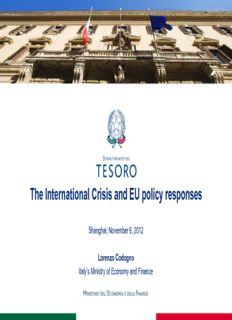
The International Crisis and EU policy responses PDF
Preview The International Crisis and EU policy responses
The International Crisis and EU policy responses Shanghai, November 6, 2012 Lorenzo Codogno Italy’s Ministry of Economy and Finance Outline The evolution of EU institutions The international crisis in the EU context The EU policy responses: financial measures. monetary measures. fiscal measures. Next steps: Enhancing growth potential. Reforming financial institutions and surveillance. 2 1950–1952 In a speech inspired by J. Monnet, R. Schuman, the French Foreign Minister, proposes that France, Germany and any other European country wishing to join them, pool their Coal and Steel resources. The Treaty of Paris, establishing the European Coal and Steel Community (ECSC) is signed in 1951. The ECSC Treaty enters into force in 1952 and J. Monnet is appointed President of the High Authority. 3 1957: The Treaty of Rome The treaties establishing the European Economic Community (EEC) and the European Atomic Energy Community (Euratom) are signed by Belgium, France, Germany, Italy, Luxembourg, and the Netherlands in Rome - from then on referred to as the Treaty of Rome. The EEC starts work and quickly establishes itself as the most important of the European communities, aiming to create a common market through a customs union plus free movement of capital and labour. 4 In or out? The UK and the EU 1963: French President General C. Gaulle questions the political will of the United Kingdom to join the community - giving rise to his famous "non" to British membership of the EEC. 1966: France pushes for retention of the unanimity vote when major interests are at stake (Luxembourg Compromise). 1967: The United Kingdom re-applies to join the Community but France is still reluctant to accept British accession. 1972: Denmark, Ireland, and the United Kingdom finally sign the treaties of accession to the European Communities. 5 1979: The road to the euro begins with the EMS The European Monetary System (EMS) introduces the European currency unit (Ecu) and the exchange rate mechanism (ERM). The ERM binds national currencies in an exchange rate band denominated in Ecus. Among other events, the first elections to the European Parliament by direct universal suffrage are held in 1979 and Greece joins the European Communities in 1981. 6 1987: The Single Market Act (SMA) By amending the original 1957 Treaty, the European Economic Community (EEC) gains an enabling instrument for the Single Market. The revised Treaty – The Single European Act (SEA) comes into effect on 1 July 1987, aiming to complete the formation of the common market begun by the earlier treaty. The SEA intends to remove barriers and increase harmonisation of policies while improving competitiveness within and across countries by sweeping away restrictive practices in a range of economic activities. This entails a vast legislative programme involving the adoption of hundreds of directives and regulations. 7 1991: The Maastricht Treaty on the European Union (1) 1984: The draft Treaty on the establishment of the European Union (Spinelli draft) is passed by the European Parliament by a large majority. 1991: The Maastricht Treaty on the European Union is signed in December. It paves the way for monetary union and establishes the euro: the UK, Sweden and Denmark decline to join the currency. 8 1992: The Maastricht Treaty on European Union (2) The Maastricht Treaty has a rough ride in national referendums. Danes reject it in June 1992 and only accept it in a second vote in May 1993, after receiving an opt-out on monetary union like the UK. In France it barely passes by just 50.4% of votes in favour compared to 49.7% against. It passes in other countries including Germany and the UK despite evidence of public discontent. 9 1997: The Amsterdam Treaty The Amsterdam Treaty prepares the EU for its eastward expansion. National vetoes are abolished in more areas. Laws on employment and discrimination are strengthened and the social chapter of the Maastricht Treaty becomes an official part of EU law. The Schengen agreement becomes law, though the UK and Ireland opt-out. 10
Description: